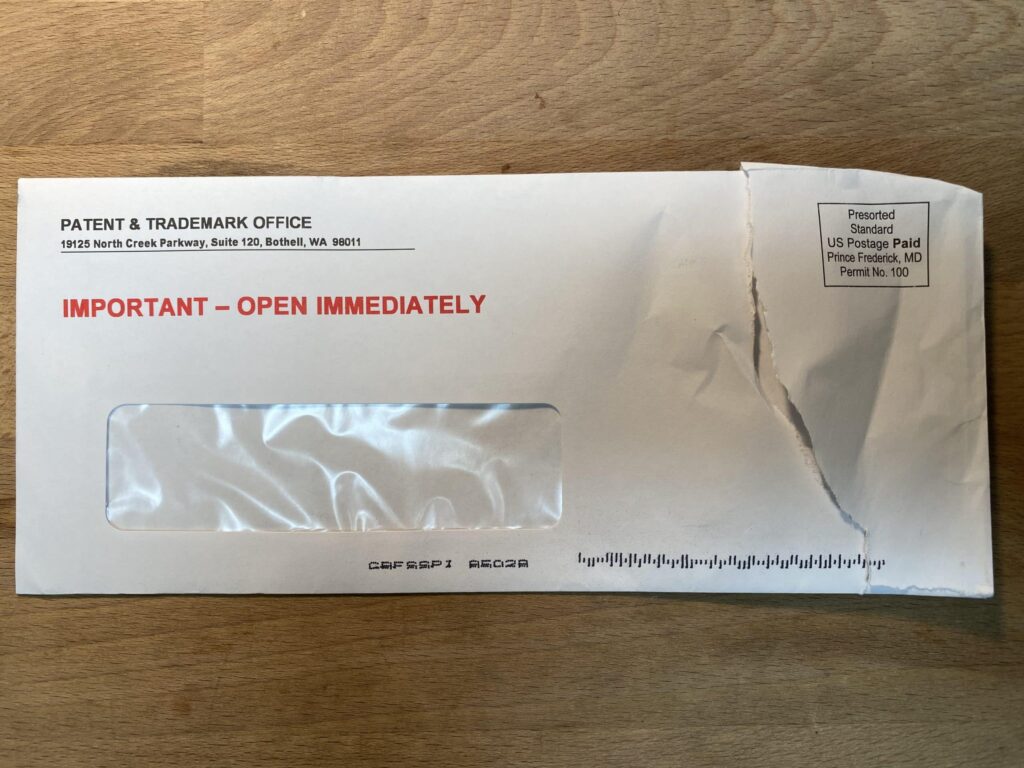

The Trademark Office may send you an office action or notice after you’ve filed maintenance paperwork in your trademark registration. The notice refuses to accept your maintenance filing until the Office is convinced that you are using your trademark on all your registered goods or services. This is called a trademark post registration audit office action.
If you have received trademark post registration audit office action and don’t know what to do, please read on. I’ve been writing, filing, and processing trademarks applications and registrations for 15 years.
Why does the USPTO audit registrations?
In 2017, the USPTO began conducting random audits on trademark registrations after mandatory maintenance filings are submitted by an owner. Maintenance filings are submissions all trademark owners must make regarding the continued use of a trademark. The filings affirm that the trademark is still in use or deletes goods and services that are no longer being offered.
The Trademark Office’s audit program checks to see if you actually are using the trademark for all the goods and services you say you are when you file your maintenance work. The Office seems to have increased the number of those audits in the past year or two. Trademark law requires that all registered trademarks be used, because a trademark is only valid if it is used. Registrations are eligible for upkeep only if the trademark is in active use for the registered goods or services, or if temporary nonuse is excused due to special circumstances. Any inaccurate or improper use claims during registration maintenance filings pose a risk to the validity of the registration, may unnecessarily obstruct future applications, and diminish the effectiveness of the trademark register in providing notice of trademark rights to businesses and the public.
Trademark owners are actually only required to submit one specimen per class when they file their declarations of use to sustain their registration. However, the Trademark Office reserves the right to check on you. In the event of a USPTO audit of a registration maintenance filing, you must substantiate the use of your trademark for the other goods and services listed in the registration. Failure to respond to the trademark post registration audit will result in the cancellation of your registration. If you respond but fail to provide evidence of use for those goods or services, you will need to remove them from the registration. Furthermore, the Trademark Office will charge you at least a $250 deletion fee per class just to remove goods or services, along with a possible $100 deficiency surcharge, or the entire registration will be canceled.
Since its inception as a pilot program, the trademark post-registration audit initiative has resulted in the cancellation or removal of goods or services from over fifty percent of audited registrations. So the risk of not responding, or not responding correctly, to a post registration audit is real.
Is it possible that my trademark registration could be audited?
Certainly. The Office runs the program on marks falling into certain categories, in sort of the same way that some activities will raise your audit risk from the IRS. Generally, having more goods or services in a class raises your risk of a trademark post registration audit. Your trademark registration may be audited if any of these are true:
- You have submitted a timely Section 8 or 71 declaration of use.
- Your registration falls into one of the following categories:
- It includes at least one class with four or more goods or services. For example, your registration may cover items such as purses, wallets, backpacks, luggage tags and suitcases, all falling under Class 18. – OR –
- It includes at least two classes, each with two or more goods or services. As an illustration, your registration may encompass:
- Purses and suitcases (Class 18)
- Clothing, namely shirts, shorts, pants, coats, and hats (Class 25)
- Retail clothing stores (Class 35).
Practical Tip: Whenever possible, submit specimens for every single product and service identified in your trademark registration. This can prevent a trademark post registration audit.
What happens if my registration is audited?
If your trademark registration is audited, you will receive a post-registration office action from a Trademark Office examiner. It will inform you that your registration has been chosen for an audit. This notice will identify two goods or services from each class that gets. You must then provide evidence of use for each of these identified goods or services. If you don’t respond, your trademark registration will be cancelled in its entirety.
Practical Tip: Contact a local trademark attorney as soon as you receive a trademark post registration audit. Responding quickly and accurately can help avoid cancellation of your trademark and can also reduce the cost of filing – or submitting multiple filings – in an attempt to respond to the audit successfully.
What happens if I don’t respond to a trademark post registration audit?
If you don’t respond, only one thing will happen: your trademark will be canceled. When your trademark is selected for an audit, you must respond if you want to keep your trademark registration alive.
Are there government fees for the audit?
Possibly – it depends on how you respond. Should you choose to remove goods or services from your registration, you will have to pay a fee of $250 for each deleted class. And here’s the rub: the government charges this fee each time you delete a class. So, if you get audited, and you delete a class, you’ll pay $250. But, the government may not like your response, will send you a second office action, and if you delete more goods or services, you’ll have to pay the $250 again.
Moreover, deleting goods or services from your filing after it is submitted is essentially an admission that you did not accurately identify the goods or services that were actually be used in commerce with your trademark. This renders your declaration deficient, and the Trademark Office may then apply a deficiency surcharge of another $100.
If you don’t remove goods or services and there aren’t any other deficiencies, you will not have to pay any government fees.
The examples below illustrate instances where a deficiency surcharge is mandated when correcting a deficiency in a Section 8 or 71 declaration during a different timeframe than the original filing.
Scenario 1
You submit your declaration at the earliest opportunity, after the fifth-year anniversary. Subsequently, you respond to an office action before the commencement of the sixth-year anniversary. Should you choose to remove goods from any class, a $250 fee is applicable for the deletion, with no additional deficiency surcharge.
Scenario 2
You submit your declaration at the start of the six-month grace period and respond to the office action within the same grace period. If you choose to remove goods from a single class, you must pay a $250 fee for the goods’ deletion, with no additional deficiency surcharge. I note that submitting your maintenance filings during the six-month grace period is extremely dangerous, because the Trademark Office is currently taking so long to review them. As of the time of this writing, I am regularly seeing the Office take 9 months or more to review a post-registration. That means that if you file in the six-month grace period, it is quite possible that the Trademark Office won’t issue the office action until that period is over.
Scenario 1 + Scenario 2
You submit your declaration in the fifth year but respond to the office action within the six-month grace period immediately following the standard statutory period, during which you delete goods from a class. In this case, you are required to pay both the $250 fee for goods deletion and a $100 deficiency surcharge. This is quite likely because of the delays in reviewing use filings by the Trademark Office.
Scenario 2 + Scenario 3
You submit your declaration on the final day of the six-month grace period. Subsequently, after the grace period concludes, you respond to an office action by deleting goods from a class. In this scenario, both a $250 fee for goods deletion and a $100 deficiency surcharge are required.
To avoid incurring fees, we recommend promptly removing any goods and services no longer in use between mandatory maintenance filings. We ask all clients whether they are using the trademark on all the registered goods and services when we prepare their maintenance filing paperwork.
Practical Tip: As the statutory period for the necessary maintenance filing approaches, ensure that the trademark is actively used for each registered good and service. Gather specimens and other evidence of use, like advertisements, packaging, labels, website screenshots. Even invoices, receipts, purchase orders, and other business use of the trademark. Gather that information and store it internally, because you may need later if your use is ever questioned by the Trademark Office or challenged by a third party.
What if I don’t pay the government fees when I respond to a trademark post registration audit?
Don’t worry, the Trademark Office will come for those fees!
If you pay the wrong amount or fail to pay at all, the Trademark Office will issue another office action. That one will specify the outstanding amount you owe and extend the deadline for payment, depending on the audit stage.
In some cases you may need to petition the Director to settle the outstanding fees. Failure to pay all fees by the conclusion of the trademark post registration audit process, or failure to respond to an office action requesting fees, will result in the cancellation of your entire registration.
What is “proof of use”?
The Trademark Office wants to see proof that you are using a trademark on the goods or services identified in your trademark registration. I usually work closely with clients to gather and select examples that best show use. The same types of proof that support a Statement of Use filing during trademark application preparation also work in a post-registration maintenance filing.
Good evidence of use serves clearly demonstrates how your trademark is actively used in commerce with the specified goods or services in your registration.
Specimens for goods may include:
- Photographs displaying the mark on a tag or label attached to the goods.
- Hangtags or labels featuring the mark along with the generic name of the goods and standard information found on tags or labels used in commerce for such goods.
- Screenshots of webpages, indicating the URL and access or print date, portraying the mark’s usage for the goods at the point of sale.
- Photographs of the mark on packaging where the goods are visible through the packaging.
- Photographs of the mark on packaging with the packaging identifying the generic name of the goods included.
Examples of specimens for service trademarks may include:
- Copies of brochures or flyers integrating the mark in advertising the services.
- Photographs displaying the mark on signage at retail stores or restaurants.
- Photographs of the mark on service vehicles.
- Screenshots of webpages, accompanied by the URL and access or print date, showcasing the mark’s use in the actual sale or advertising of the services.
Digitally created or altered photographs or other mockups are not acceptable forms of proof of use.
What happens after I respond to the first office action?
If your response fulfills all the requirements laid out in the office action, including providing acceptable proof of use, the USPTO will issue a notice of acceptance.
If your response does not present acceptable proof of use for the audited goods or services in a particular class, or if it solely deletes such goods or services without presenting acceptable proof of use on the others, a second office action will be issued. This second office action will require proof of use for all goods/services for which proof of use was not been provided. Note: Proof of use is not required for classes that were either not initially audited or were audited and then accepted.
As noted above, if you delete goods or services then you are also going to have to pay the $250 deletion fee and possibly a deficiency surcharge of $100. If your response omits the required fees, a second office action will communicate the total outstanding amount and warn of the potential cancellation of your entire registration if the total amount due is not paid.
What if I am unable to furnish evidence of use for the goods or services that are subject to the audit?
If you can’t show that you are still using the trademark on the goods or services subject to the audit, you should delete those goods. It is that straightforward.
I have found that some clients are really reluctant to delete goods or services from their trademark registrations. It feels like they are giving up something. But, if you are not selling the product, you have no right to continue to register the mark for that product. And, if you’re not selling the product, you’re not selling the product! Don’t try to hold on to protection that isn’t there.
Trying to keep a registration alive on more goods and services than you are still offering will create problems and expenses in the near future. The Trademark Office will probe and continue to ask you and charge you to explain your use.
Practical Tip: Be honest with yourself or your trademark attorney about what products and services you are still offering. Submitting proof of use for the audited goods or services in response to the initial office action, with no additional issues in your declaration, is the best way to prevent the issuance of a second action.
Is it possible for me to receive a third office action?
Yes, the Trademark Office will send a third office action if your responses to the first and second ones are unsatisfactory. If there are goods or services still present in the audited class(es) of your registration lacking acceptable proof of use, or if you haven’t paid the necessary fees for deleting goods or services or the deficiency surcharge, the Office will send yet another office action.
What happens if I choose not to respond to the third office action?
Even if acceptable proof of use has been provided for certain audited goods and services or some of the required fees have been paid, failure to either address any remaining issues by responding to the third office action or filing a petition to the Director will result in the complete cancellation of the entire registration.
Practical Tip: Do not ignore any office action sent from the Trademark Office, whether it is a first, second, third or any other type of communication.
What is the procedure for addressing a third office action?
You have two options for responding to a third office action:
- Submit a response to the office action within six months of its issuance date. This response should request the deletion of goods or services lacking acceptable proof of use and include payment for the deletion fees and deficiency surcharge, if applicable. Do not present new proof of use evidence; the examiner will not consider any additional evidence submitted.
– OR –
- File a petition with the director of the Trademark Office within six months of the issue date of the office action. This allows you to request a review of the audit examiner’s decision or submit new proof of use evidence. A petition will not necessarily overcome the office action. To the contrary, unless the Examiner is egregiously wrong, the petition will probably be denied.
Is it possible for me to submit a new Section 8 or 71 declaration instead of responding to an office action?
This is a bit of a creative option, but yes, you can do this. If there is still time within the one-year filing window, you can submit another declaration. However, be aware that the new declaration will incur a new set of filing fees.
The trademark post registration audit applies to your trademark registration, not your filing. As I explained above, it is the characteristics of the trademark registration that affect your audit risk. Therefore, it is possible that you will still receive another office action upon filing your second declaration.
When do I need to submit the declaration of use and other maintenance paperwork?
You have to file maintenance documents periodically and regularly during the life of a trademark registration, generally on the 5 year and 10 year anniversaries of the registration and then every ten years thereafter.
For the first declaration of use, the window is one year long and is extendable. You have the option to file as early as the fifth-year anniversary of your registration date or as late as the sixth-year anniversary. If you choose to file during the six-month grace period, you can pay an extension fee during that period.
For ten-year declarations of use, the window is also one year long and extendable. You can file as early as nine years after your registration date or as late as ten years after your registration date, and then again between every ninth- and tenth-year anniversary thereafter. Like six-year declarations, an extension of six months is available by paying the fee when filing during the six-month grace period.
Practical Tip: File as early in the window as possible. Doing so will ensure that you have time to respond to any issues that the Trademark Office raises. The Office often takes a long time to review these filings and may not respond until very late in the window or even outside the window, which limits your response options.
How much time do I have to respond to either the first or second trademark post registration audit office action?
Your deadline is the later of the following:
- Six months after the issue date of your office action; or
- The conclusion of the one-year statutory filing period.
What happens if I fail to respond to either a first or second office action?
Failure to respond to an office action by the deadline will result in the complete cancellation of your registration. However, if exceptional circumstances hindered your ability to respond promptly, you have the option to submit a petition seeking a waiver of the rule that mandates a timely response. Examples of extraordinary circumstances may involve:
- Impacts from a hurricane or flood that prevented the timely submission of a response.
- Non-receipt of the office action.
The Office will not lightly grant these petitions, and you will have to incur costs and show evidence to support your petition. For further details, refer to TMEP §1708.
What if I have a disagreement with the determination made by the post-registration examiner?
If you disagree with the rejection of your proof of use after the issuance of the third office action, you have the option to file a petition. I do not have any experience with a petition of this kind. Nonetheless, based on the way the Office reviews other petitions similar to this, my suspicion is that this will generally be a waste of time. Unless there is something egregiously wrong with the audit, the Office will probably side with the examiner.
Please note that there is a fee associated with this petition. The Director will thoroughly review the case to ascertain whether there was an error made by the audit examiner. If you possess additional proof of use that you wish to be taken into consideration, you can submit it along with your petition. Clearly identify the goods and services for which you believe this additional proof of use is relevant. And good luck.
It is also essential to settle any outstanding deletion fees and/or deficiency surcharge to avoid the cancellation of your entire registration.
Is there a specific way to respond to an office action?
The Trademark Office requires electronic filing with its online forms. For a trademark post-registration audit response, you can use the Response to Office Action for Post-Registration Matters form.
The form will walk you through a series of pages that request different types of information. Unfortunately, the Trademark Office’s forms are not user friendly. They contain a lot of densely-packed information and required fields and information are often buried in places you might not see. Be very careful when filling the forms out. I actually get a lot of calls from people who have all of the information collected properly on their side but are just unable to navigate the Office’s confusing forms.
You will need to upload an image file displaying your evidence of continued use of the trademark. You will also have to make and swear to the declaration. The trademark declaration requires the signature of an authorized individual, along with the signer’s name, title, and date.
What is the process for filing a petition to the Director?
I strongly recommend that if you have gotten to the point where you are considering filing a petition, you should contact a local trademark attorney. There may be other, better ways to respond to the Trademark Office than filing a petition. There is, however, an online form at the Trademark Office website that you can use to submit the petition. I am not going to link to it here because I so strongly think a petition is something that should only be filed by a trademark attorney.
Other questions about trademark post registration audits?
The above is pretty comprehensive. However, if you have received an post-registration audit office action or have any questions about post-registration filings and processing, please contact me, Phoenix trademark attorney Tom Galvani before responding to the Trademark Office. I may be able to help you prepare and file a response to prevent your trademark from receiving more office actions, becoming subject to unnecessary fees, or having your trademark registration cancelled. I’ve been doing this a long time, and I’d love to talk and help you next.





